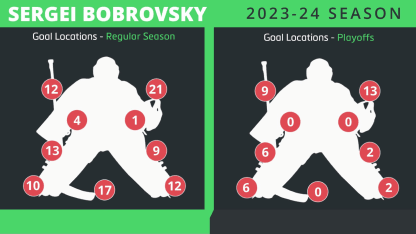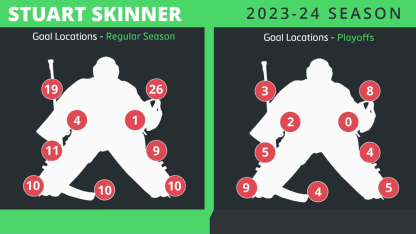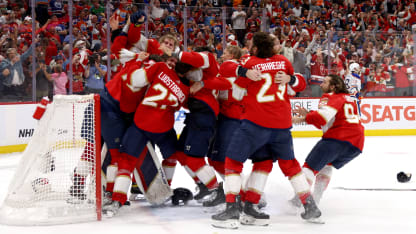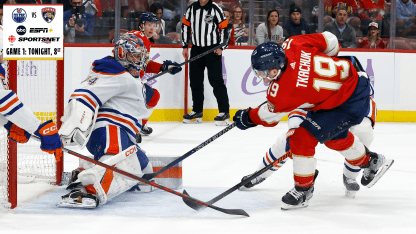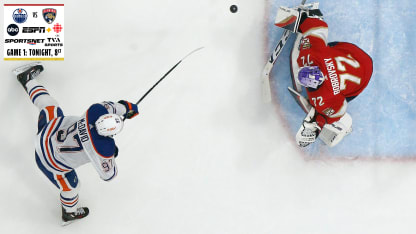Bodies to the net for scrambles: After being average or slightly better in the regular season on scramble goals (17 percent compared to 14 percent tracked average) and screens (14 compared to 15.1 percent average), both numbers are up in the playoffs. Screens are at 22.5 percent (9-for-40) including four of 12 goals in the West Final, and 14 of 40 playoff goals have come off scrambles and broken plays (35 percent) that expose side-to-side recovery delays when moving from his knees, caused in part from having a narrower butterfly, which is more than double the tracked rate of 14 percent in the regular season. These plays account for most of the nine goals along the ice, especially on the blocker side, and make it increasingly important for Edmonton defenders to win their battles in front of the net.
Tips too: After being a primary factor on just three tracked goals in the regular season and none in the first round, deflection goals were also up in the second round (four of 15) and played a role (five of 12) in the west final, with three tipped into the net and two other redirected to create the above-mentioned broken plays. Skinner tends to play a little deeper, typically staying well inside the crease, which creates less coverage on pucks changing direction.
Far side off the rush: Edmonton doesn't give up much off the rush under Knoblauch, but rush-type chances were still a factor in six of 12 goals in the West Final, and clear-cut rushes showed a season-long susceptibility to far-side, or against-the-grain, shots. These include Wyatt Johnston's goal in the opening minute of Game 4 and Jamie Benn beating Skinner clean along the ice on the far side on a 2-on-1 early in Game 2. They matched the regular-season trend among 25 percent against-the-grain goals: shoot low-blocker skating down the right wing and high glove when skating down the left were the most successful shots, targeting a tendency to retreat on the rush flat to the goal line, which opens the far side.
Get him moving into (and playing outside) his posts: The Stars scored four of 12 goals off plays from below the goal line, including one shot off the end boards that stranded Skinner outside his post after overplaying the initial attempt on their only goal in Game 6, something the Canucks also used to score in the second round. But the more targetable trend was getting him to play on his posts on plays from sharp angles and wraparounds. Though most will point to Skinner hitting the post with his skate and leaving a gap under the pad that Jason Robertson exploited to bank the winning goal in off him in Game 3, it's the position of his other skate that is more problematic on these plays. Because Skinner tends to leave his anchor skate up ice toward the top of the crease rather than flattening it out closer to the goal line he enters a RVH on the post, he's also more vulnerable to short-side high shots from bad angles, like the goal by Canucks defenseman Nikita Zadorov in Game 2 of the second round, and slower to move post-to-post on wraparounds, which can leave him behind the play on pass outs on the other side, like Johnston's tap-in goal in Game 3, a tough play but one Skinner never caught up with after Benn went behind the net.
Early passes off the rush, down low in-zone: Plays across the middle of the ice increase the odds of scoring on any goalie, and more so, one with relative lateral limitations, but where to makes those plays on Skinner depends on the type of chance. On rush plays, lateral passes are more effective higher in the zone because of a tendency to either slide or pitch forward and get off balance coming across. On in-zone play, passes through the middle are more effective below the hash marks, creating a big lateral rotation that sometimes leaves him stuck, and any chance to take the puck across the top of the crease in a one-on-one situation, can leave him pitched forward without coverage to the post like he was on a Benn breakaway in Game 1 that led to a Tyler Seguin tap in on the other side.
Active rebounds: Skinner's numbers improved on rebounds this season, with 12 goals as a result, slightly above the tracked average of 11.7, and only 2-for-40 in the playoffs. Some of that may be how fast and hard pucks are bouncing off the new CCM AXIS XF pads he was the only NHL regular to use this year. Designed to create more active rebounds, it means second chances, especially on pass-off-pad plays, will bounce faster past attackers near the edge of the crease, making it better to look for those pucks further out.

